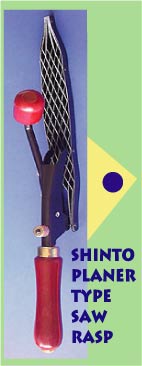Monday: We have arrived at the put in, aka the Santa Elena take out, near Castolon, Texas (just inside the western border of Big Bend National Park), unloaded the boats and gear. Four boats, four people, Chuck and I, our son Joe, and Skip Johnson, good friend and long time paddling buddy. Skip has brought Easy B, his custom canoe; Chuck and I have our Michalak Rio Grande kayaks, and Joe is taking his Old Town sit inside kayak. Chuck leaves to drive the Jeep back to Rio Grande Village, our take out, where he will be picked up by our shuttle and brought back to us, and we bob and weave and reorganize the elements of our gear. How in the heck is all this stuff going to fit in our boats? The worst part is all the water we have to carry. This is not a river you can use a water filter on like we do at Lake Powell, what with all the industrial waste that goes in the water upstream and the cows and horses that live on the banks. The recommended amount is a gallon a day per person, and we are planning five days. It needs to be distributed in the boat to make the load at least somewhat even.
The river is running about 150-175 cfs, or cubic feet per second of flow. Two weeks ago (I have been watching the charts every day for a month), it was close to 9000 cfs, apparently due to tropical storms in the Pacific that landed on the west coast of Mexico. The mud deposited high on the banks confirms that high water. Most of the flow in the Rio Grande past Presidio really comes from the Rio Concho, and a good part of that flow comes from the dams in northern Mexico that preserve water for irrigation. When they get full, and let water out, the Rio Grande in Big Bend can flood. When Chuck gets back with Rick, the shuttle driver, he says that Rick says the dams in Mexico are at 98% capacity, and may be releasing soon. A little sobering! But we are still hoping it will come up a bit, hopefully not more than 1000 cfs or so!
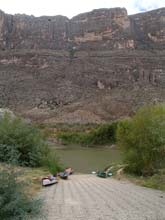 |
...the put in, aka the Santa Elena take out, near Castolon, Texas (just inside the western border of Big Bend National Park) |
Chuck and Skip have run the 75 miles of the GURG (Great Unknown Rio Grande) twice before, and I have done it once before, Joe never. We take off, planning to make at least 10 miles downstream before we stop for the night. This part of the river is mostly open country, and there are long stretches of paddling, punctuated by the occasional gravel bar, a bit of dragging over rocks and then a nice fast sweep along the bank under river cane. The cane would like to trap us, and we paddle hard to stay beside it instead of under it. The cane is apparently considered an invasive species, not something I entirely understand—it appears to anchor the bank which is largely loose mud and clay, and subject to erosion, but then I don't know what was there before the cane. A little research perhaps.
Ten miles down, we find a good site to camp. It has been cloudy all day with big thunderclouds off to the north and southwest, and we want to be up high enough to not worry about the river coming up in the night, and also have something solid to attach the boats to. To be honest, I cannot remember much about the spot other than that Joe decided to set his cot up by the river so as to keep an eye on it, and Chuck and I and Skip were back away from the water in tents. I do remember that sometime after midnight it began to sprinkle, and I was glad I had given Joe my big poncho, just in case—he sleeps open, no tent. The sprinkles quickly turned into a good shower, lasting long enough to reanimate the sticky mud.
| The cane would like to trap us, and we paddle hard to stay beside it instead of under it. |
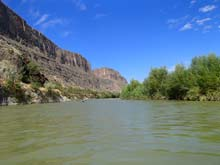 |
Our goal for Tuesday was 20 miles, which would put us within about 15 miles of the entrance to Mariscal Canyon. Still cloudy, keeping the real heat at bay. Late September is not the ideal time to be on the river, still a bit warm, but we were taking advantage of our son Joe's 10 days off. No extra water coming down yet, but I am starting to get my "river legs", starting to remember how to read the drops, read the sweeps, avoid most of the rocks. My Rio Grande kayak is more heavily built than Chuck's—I tend to go a little faster and maybe hit or graze a few more of the rocks. Mine is plywood, reinforced with fiberglass and some Kevlar. Chuck's is foam core, lighter but also covered with fiberglass and Kevlar. Other wise, they are identical, and we both have waterproof compartments front and back with access through Sealect kayak hatches. Directly behind the cockpit is a large rectangular space, built with a lip and a cover that is strapped on with bungee cord. This one is going to take on water when and if we turn over, but we keep things in there that can get wet.
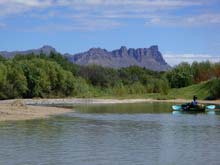 |
Joe pauses to take in the grandeur of the Chisos Mountains. |
Tuesday is a long day, and when we start looking for a good camp, they are just not there. Ideally, we want a wide spot where rising water could spread out with gravel bar for the boats, a tree to tie them too, and a nice bank about 10 or 15 feet up with good flat spots for tents. We finally settle on a less than ideal spot that does get us up above the river—not as far up as we would like and also a bit narrow, with a thick growth of cane just up from the tent spots. There is an escape route through the cane, but we hope we will not need it. We are all tired.
When I wake up at 12:30AM, listening to the water, it sounds fine, but when I look down at the flow, now illuminated by the moon, I can see it has risen and is running a good bit faster than it was when we went to sleep. The boats are floating and the gravel bar has disappeared. Skip had stuck a 12" or so stick in the bank earlier, and it has disappeared under the water. We have the moonlight, but no clue if the rise will continue or not, so we take the camp apart, load the boats and get ready to either take to the boats or higher ground. After an hour or so, it looks like the level has stabilized, maybe even gone down a bit, but then Skip recalls hearing about a pattern where that seems to happening, but then there is another surge and rise. So we wait, taking turns on watch and sleeping on the ground with our heads on life jackets. I start thinking I am too old for this, but really don't have much choice, so fall asleep anyway.
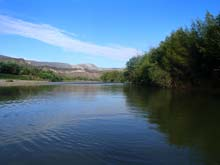
Before the rise, the river is clear(ish) and calm... |
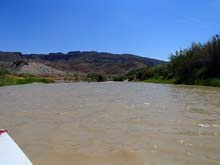
...afterwards, it is muddy and running fast. |
Daylight takes forever, but the river stays the same, and all of us being eternal optimists, this water level is starting to look like fun. It also looks like chocolate milk now, having picked up a load of silt and clay that is pale brown. We will find out later that we now have about 800 or 900 cfs, which is almost perfect. High enough to get us over most of the rocks, high enough to take the class 1 rapids up to class 2 and the occasional "almost" class 3, depending on how fast the drops come and how close together they are and how fast we have to turn to make the next one. I manage to get too close to the river cane on one of the sweeps, and get stuck. I cannot back up, the rushing water has me pinned. I can see the guys are trying to get to me, help me pull back out, but before they can, I lean too far over and the water fills the cockpit and we go over. It is deeper than I thought, but somehow easier to extract now, and I grab the boat and they help me swim over to the shallows and the guys help me flip it and bail things out.
We make excellent time, and not long after lunch, we are at the beginning of Mariscal. It is like entering some sort of time warp as the walls rise around us and the sounds of the river echo off the sides. Birdsong and small bird flight follow us along. The first challenge is the rock pile, and we all make the twists and turns with little problem. A bit farther on is the Tight Squeeze. This is chuck's third time thru this canyon, and the first time, he lined his boat thru the Sqeeze. He came home with tales of the challenge—how others ran it and did fine, some turned over, and some lined it like him. So when we went the first time together, (a trip we made with Louis Aulbach and others) I was understandably nervous. The river was quite low by the time we got to the canyon, and at some point, someone said, "Well, the tight Squeeze was pretty easy this time!"
"What??? We already went thru?" They all laughed at me.
| We stop to scout the "Tight Squeeze" |
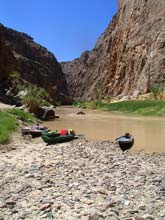 |
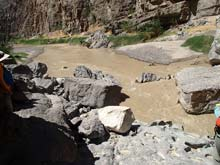 |
It looks a little scary. |
This trip, it definitely looks a little scary. We stop and climb up on the rocks above the giant boulders creating a zig zag in the river and scout. . Joe, our 33 year old, says, "I can do this." Goes back, climbs in his kayak, and runs it perfectly. Skip watches Joe go thru, and changes his mind about lining, and has a successful run. Chuck and I decide to line it together, boats tied back to back. We have to climb up over the big rocks along the side and pass the front and back lines along as we go, but it works way better than my imagination says it might, and we are soon on the other side. Separating the boats, he has me climb into mine first and paddle away. I stop a ways along and wait, sure he will be right behind me. When he does not appear, Joe paddles back to see, and Chuck has got a knee wrong getting in, and capsized. (Now we are even, having both capsized once on a previous trip, and now both once this time—not that we are keeping score or anything, but we are both oldest kids.)
Joe makes it through
Once all that is sorted, we have a short paddle to the Cross Creek camp spot. It is only about 3, but we are all tired and wired and inspired by the beautiful canyon, so we set up a shade shelter and relax. As I recall, we were all sound asleep by 8pm, and slept peacefully—no more river rises, even though Joe slept by the water to keep watch. I woke a couple of times and checked the boats to make sure they had not moved, and watched the stars for a while. Nothing like a dark canyon in the middle of nowhere for stars. Orion, Cassiopeia, Cygnus, and a million more than we ever see at home.
| Cross Creek Camp - shade shelter |
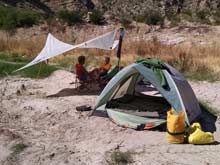 |
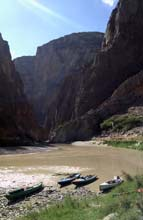 |
Mariscol Canyon - Mexico on the left, Texas on the right. |
Thursday, the river is down just a bit. We take our time in the 5 miles out of the canyon. It is just a giant rock garden complete with birds, the occasional bump and splash of a fish, and just the sheer rock walls soaring. Just outside the canyon are 5 horses grazing on the US side bank. Some miles down river we will encounter our first humans, a father and small son on horseback from the Mexico side, looking for lost horses. We try to tell them where we saw the five, but I am not sure we were understood. We have decided that if all goes well, we will make it all the way to our take out today. We have good current, and the total distance for the day is about 25 miles.
We are heading northward now, Mariscal having been at the bottom of the big bend, and we have thunderheads and dark skies off to the north. We also have a headwind which slows us, but our average speed is about 3 miles per hour. Skip is the strongest paddler. I suspect Chuck and Joe could paddle just as fast as Skip, but they are going my speed, and I am happy for that. I have found that I can paddle all day without any particular problem, but I am like the tortoise, not the hare, and like to just keep it steady.
The rain never reaches us, and the wind backs off a bit, and with only 5 miles left, we get a little euphoric and take one last break and make for the take out. It appears just as chuck's GPS dings that we have arrived. The take out is deserted, and we get the boats out and unloaded, while Chuck goes to get the Jeep. He returns with excellent news—there are showers at Rio Grande Village, and they are open 24/7. We just need quarters. We have all been in the same clothes for 4 days. We head for the campground, have a quick dinner, and go look for showers. They are beautiful showers, and 5 minutes under a hot spray is heaven. It has been a perfect trip all around. One last desire to be met—we will stop in Fort Stockton on the way home for a TEXMEX lunch (delicious).
| Loaded for the trip home |
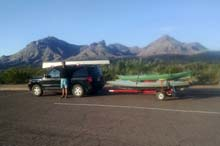 |
|




